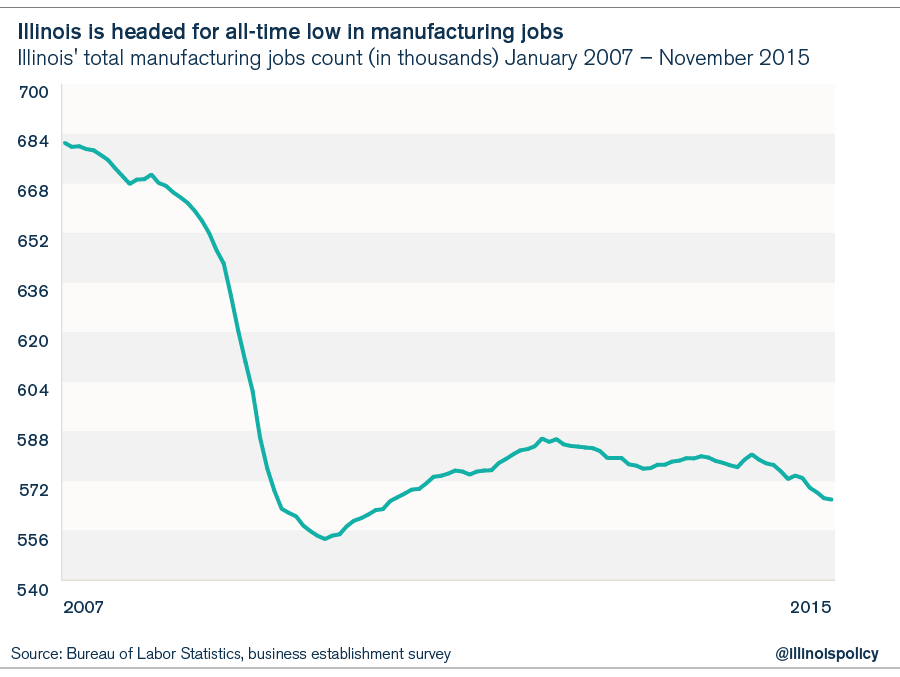Illinois ended 2015 down 14,500 manufacturing jobs, closing in on an all-time low for factory work
Illinois’ manufacturing job losses accelerated in 2015, while most neighboring and Great Lakes states continued to post gains in factory jobs.
As 2015 came to an end, Illinois quickly closed in on a new all-time low for manufacturing jobs, with a net of 14,500 factory jobs lost through the first 11 months of the year, according to data from the Bureau of Labor Statistics.
Illinois hit its lowest point for manufacturing jobs at the absolute bottom of the Great Recession in January 2010. After years of gradual decline, the Great Recession caused industrial states to sink to their worst levels for factory work in decades.
Most states have experienced a significant recovery of manufacturing jobs since the recession bottom. And even Illinois experienced a slow recovery for two years, from January 2010 through July 2012. But after that brief recovery, Illinois has been losing manufacturing jobs for more than three years, and is on pace to reach a new all-time low as soon as the end of 2016.
Illinois’ manufacturing jobs recovery ended in July 2012, and since then, the flow of manufacturing losses has resumed. The Land of Lincoln has lost 19,600 manufacturing jobs on net since July 2012, while surrounding states have continued to add factory jobs during the same time period.
Illinois job losses accelerated in 2015, with a net 14,500 factory jobs lost on the year, accounting for the majority of Illinois’ job losses since the summer of 2012. Meanwhile, most surrounding states continued to post gains in factory jobs in 2015.
If Illinois loses the same number of manufacturing jobs in 2016 as it lost in 2015, the Land of Lincoln will reach a new all-time low for manufacturing work. These working-class jobs are disappearing in significant numbers in Illinois alone, pointing to Illinois-specific problems. Manufacturers who have left Illinois have laid out the reasons, citing out-of-control property taxes and a broken workers’ compensation system, among other problems.
The Illinois Policy Institute supports a legislative agenda to counter these anti-worker policies and kick-start hiring and new investment in Illinois’ manufacturing sector. Structural economic reforms will allow Illinoisans to leverage the state’s location, talent and resources to create more jobs, increase incomes and manufacture more made-in-Illinois products. The package of reforms should include:
- Regulatory reform to fix Illinois’ broken workers’ compensation system, which drives manufacturing jobs out of the state
- Regulatory reform to improve the state’s anti-business lawsuit climate
- Tax and spending reform to freeze and lower the nation’s second-highest property taxes and allow local governments to control budget costs
- Tax reform to exempt businesses from sales taxation on the purchase of business inputs. This would broaden the concept behind the manufacturers’-purchase credit and the manufacturing- and machinery-equipment credits so that Illinoisans only pay sales tax on final products, not on the inputs used to make them.
- Statewide or local Right-to-Work laws to attract new investment and protect worker paychecks
- Education reform to bring shop class back to high schools. A broader vision of education should include in manufacturing areas schools that specialize in training students for careers as makers, so that interested students can graduate ready to succeed in good manufacturing jobs.
Illinoisans are ready to compete in manufacturing against other states and countries; they can win with better brains and brawn and a superior location. But none of that matters if industry is smothered by misguided policies. Economic reforms should be enacted to unleash Illinois’ sectors that have long suffered under the policies of industrial malaise.



